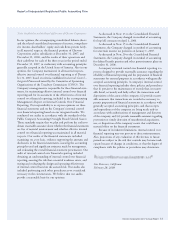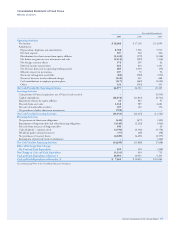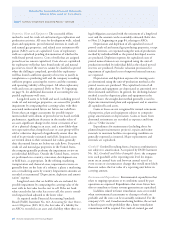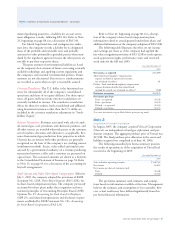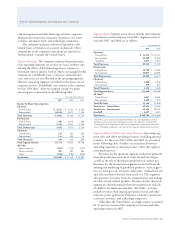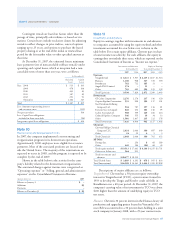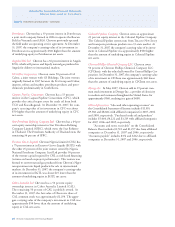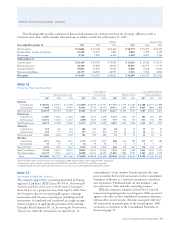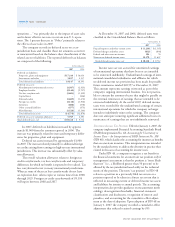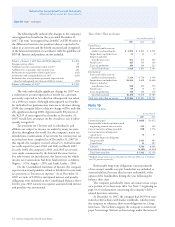Chevron 2007 Annual Report Download - page 65
Download and view the complete annual report
Please find page 65 of the 2007 Chevron annual report below. You can navigate through the pages in the report by either clicking on the pages listed below, or by using the keyword search tool below to find specific information within the annual report.
63
Year ended December 31
2007 2006 2005
Sales and other operating
revenues $ 153,574 $ 145,774 $ 137,866
Total costs and other deductions 147,510 137,765 131,809
Net income 5,203 5,668 4,775
At December 31
2007 2006
Current assets $ 32,803 $ 26,066
Other assets 27,401 23,538
Current liabilities 20,050 16,917
Other liabilities 11,447 9,037
Net equity 28,707 23,650
Memo: Total debt $ 4,433 $ 3,465
Chevron Transport Corporation Ltd. (CTC), incorporated in
Bermuda, is an indirect, wholly owned subsidiary of Chevron
Corporation. CTC is the principal operator of Chevron’s inter-
national tanker fleet and is engaged in the marine transportation
of crude oil and refined petroleum products. Most of CTC’s
shipping revenue is derived from providing transportation serv-
ices to other Chevron companies. Chevron Corporation has
fully and unconditionally guaranteed this subsidiary’s obliga-
tions in connection with certain debt securities issued by a third
party. Summarized financial information for CTC and its con-
solidated subsidiaries is presented in the following table:
Year ended December 31
2007 2006 2005
Sales and other operating revenues $ 667 $ 692 $ 640
Total costs and other deductions 713 602 509
Net income (39) 119 113
At December 31
2007 2006
Current assets $ 335 $ 413
Other assets 337 345
Current liabilities 107 92
Other liabilities 188 250
Net equity 377 416
There were no restrictions on CTC’s ability to pay divi-
dends or make loans or advances at December 31, 2007.
Retained earnings at December 31, 2007 and 2006, included
approximately $7,284 and $5,580, respectively, for the com-
pany’s share of undistributed earnings of equity affiliates.
At December 31, 2007, about 120 million shares of
Chevron’s common stock remained available for issuance from
the 160 million shares that were reserved for issuance under
the Chevron Corporation Long-Term Incentive Plan (LTIP).
In addition, approximately 454,000 shares remain available
for issuance from the 800,000 shares of the company’s com-
mon stock that were reserved for awards under the Chevron
Corporation Non-Employee Directors’ Equity Compensation
and Deferral Plan (Non-Employee Directors’ Plan).
For the financial and derivative instruments discussed below,
no material change in market risk occurred relative to the
information presented in 2006.
Commodity Derivative Instruments Chevron is exposed
to market risks related to price volatility of crude oil, refined
products, natural gas, natural gas liquids, liquefied natural gas
and refinery feedstocks.
The company uses derivative commodity instruments to
manage these exposures on a portion of its activity, including
firm commitments and anticipated transactions for the pur-
chase, sale and storage of crude oil, refined products, natural
gas, natural gas liquids, and feedstock for company refineries.
The company also uses derivative commodity instruments for
limited trading purposes.
The company uses Inter national Swaps and Derivatives
Association agreements to govern derivative contracts with cer-
tain counterparties to mitigate credit risk. Depending on the
nature of the derivative transactions, bilateral collateral arrange-
ments may also be required. When the company is engaged
in more than one outstanding derivative transaction with the
same counterparty and also has a legally enforceable netting
agreement with that counterparty, the net marked-to-market
exposure represents the netting of the positive and negative
exposures with that counterparty and is a reasonable measure
of the company’s credit risk exposure. The company also uses
other netting agreements with certain counterparties with
which it conducts significant transactions to mitigate credit risk.
The fair values of the outstanding contracts are reported
on the Consolidated Balance Sheet as “Accounts and notes
receivable,” “Accounts payable,” “Long-term receivables –
net” and “Deferred credits and other noncurrent obligations.”
Gains and losses on the company’s risk management activities
are reported as either “Sales and other operating revenues” or
“Purchased crude oil and products,” whereas trading gains and
losses are reported as “Other income.”
Foreign Currency The company enters into forward exchange
contracts, generally with terms of 180 days or less, to man-
age some of its foreign currency exposures. These exposures
include revenue and anticipated purchase transactions,
including foreign currency capital expenditures and lease com-
mitments, forecasted to occur within 180 days. The forward
exchange contracts are recorded at fair value on the balance
sheet with resulting gains and losses reflected in income.


